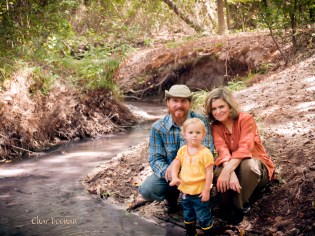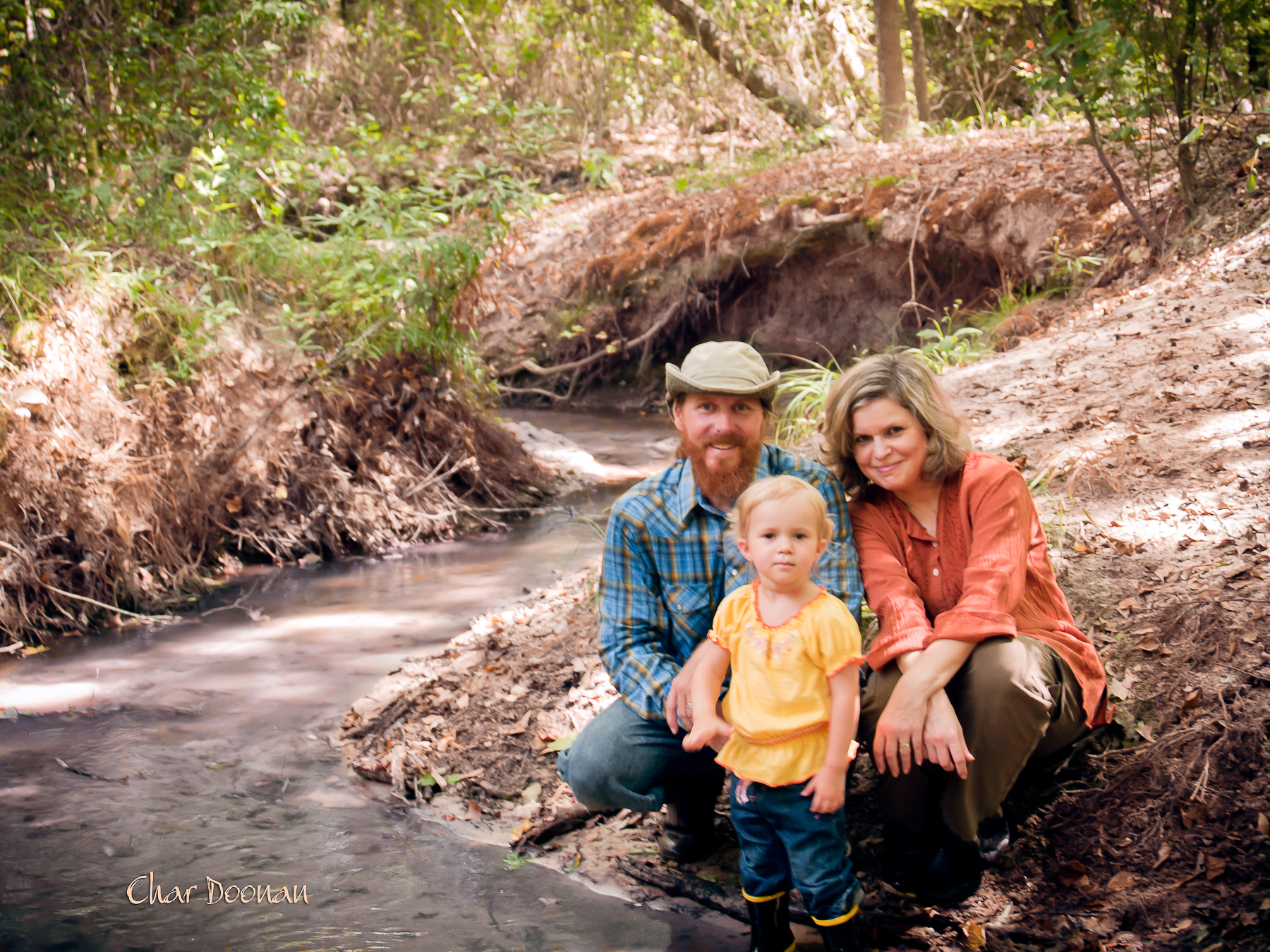
The author and his family on their property. (Photo by Char Doonan.)
President Obama is in Cushing, Okla., where he issued a specific memorandum to federal agencies, not just to build, but to expedite the approval of the southern leg of the Keystone XL tar-sands pipeline.
Many concerned citizens are also in Cushing today. Indigenous communities, landowners, environmentalists, and Occupy activists showed up strong in spirit in opposition to the pipeline.
But they weren’t at the pipe yard from which President Obama trumpeted his plan to expedite the southern segment — a pipe yard owned by TransCanada, the Canadian oil company backing Keystone XL. These concerned citizens were fenced into a “free speech zone” six miles away from where President Obama stood, threatened with arrest if they attempted to leave the designated area.
Why does this concern me? I am David Daniel, a carpenter and landowner living in Winnsboro, a small community of 3,000 in East Texas. The southern leg of the pipeline, if approved, would cut straight through my property and the heart of my community. This pipeline would carry tar-sands oil — the world’s dirtiest oil — from Cushing, Okla., past my home to refineries in Texas.
My wife Clara and I bought our land, 20 acres of heavily wooded property with spring-fed creeks and century-old hardwoods, for its utter beauty and seclusion. I then personally built the house of our dreams, with the intention of raising our daughter, Naida, and living out my years with my wife.
This property was intended as a legacy for our 4-and-a-half-year-old daughter. My wife and I never imagined that we would live to see any part of it threatened by the greed of Big Oil and the shameful complicity of a president bending over backwards to accommodate that greed.
I am concerned. I am concerned because of what I know about the proposed pipeline, and I am concerned because of what TransCanada is hiding from me, and other landowners like me, all along this pipeline’s path.
We know that tar-sands oil is more toxic than conventional oil.
Pipeline safety regulators at the Department of Transportation haven’t yet studied the safety of pipelines that carry tar-sands crude or set forth specialized regulations [PDF] for such pipelines, despite safety concerns unique to corrosive tar-sands oil compared to conventional crude oil. These pipelines must operate at higher temperatures and pressures to move the thick tar sands through a pipe and are subject to severe problems with leak detection and safety issues [PDF] from the unstable mixture. And yet, I’m told that a full analysis of this unstable mixture is not possible because potentially dangerous chemicals mixed in with the tar-sands sludge are considered proprietary information, and no one holds that knowledge but TransCanada. My family has the right to know about anything that might endanger our health or our land.
We know that tar-sands pipelines have spilled and will continue to spill.
Indeed, after the Keystone I pipeline — Keystone XL’s predecessor — spilled 12 times in its first year of operation, pipeline safety regulators issued a Corrective Action Order to TransCanada, indicating that continued operation of that pipeline would be a “hazard to life, property, and the environment.” This past summer, I visited the site of the Kalamazoo River in Michigan, where almost two years ago, a million gallons of tar-sands oil spilled and crept towards the Great Lakes after a pipeline burst in the wee hours of the night. Almost two years later, the cleanup costs have surpassed $700 million, small businesses are hurting, property values are down, and miles of river remain closed. I met residents who are still sick from the spill’s toxins, experiencing seizures, mysterious rashes, headaches, and memory loss.
We know that the southern leg of Keystone XL would permanently cross communities’ water sources and land.
Because tar-sands oil is so particularly toxic and because tar-sands pipelines have been built to spill, the southern segment pipeline puts our home and community — and many others’ — at risk of oil spills and pollution to air and drinking water. The southern segment of Keystone XL would cross Texas’ Carrizo-Wilcox Aquifer [PDF] and its sensitive outcrops. This aquifer supplies water to 10 to 12 million people in Texas. The part of my land that would be permanently crossed by the pipeline is 50 feet wide and the part set aside for construction is 170 feet wide — if the pipeline is built, that area can never be replanted or grow back to its original state. My daughter will never see the land intended to be our legacy grow back in her lifetime. According to TransCanada officials, the pipeline would be in service for at least 100 years, until they, and I quote, “drain the tar sands dry.”
We know that TransCanada has constantly used intimidation tactics to seize private land along the pipeline route.
TransCanada has used lawsuits and threatening letters to bully American ranchers, farmers, and other landowners along the proposed pipeline route. The Texas Landowner’s Bill of Rights [PDF] says plainly: “Your property may be taken only for a public use.” Yet, it’s clear that this pipeline serves one purpose: to inflate the private profits of TransCanada and the tar-sands industry at the expense of landowners and citizens.
Here’s why: As an export pipeline, Keystone XL, and the southern segment as the key link to Gulf Coast refineries and international ports, will have no impact on U.S. dependence on Mideast and Venezuelan oil and this pipeline would not protect the U.S. from the price volatility of the global oil market. According to what TransCanada told Canada’s National Energy Board, the pipeline would boost Canadian oil producers’ revenues by upwards of $3.9 billion. Bloomberg also reports it could raise Midwest gas prices by up to 20 cents a gallon, hurting landowners, farmers, and middle-class Americans. The goal of the pipeline is to transport oil to private refineries before being sold abroad, boosting oil prices rather than lowering them.
So the million dollar question today is: Does the president stand with American families and their right for clean water, air, and land or does he stand with Big Oil in its never-ending quest to wring private profits from the tar sands? With his announcement in Cushing to fast-track the approval process for the southern segment of the Keystone XL, it would seem that he’s already made his choice.



